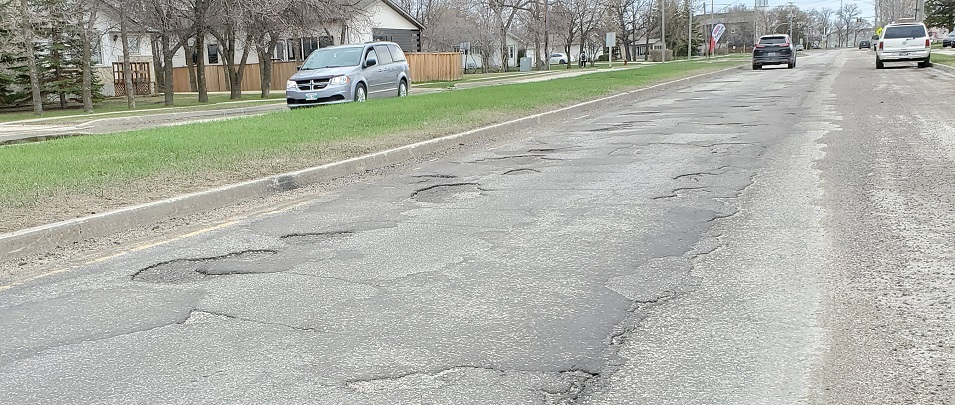
It’s just about time to call it quits on 2024 and already the previous year feels like a blur. Before we set our sights on the future, though, let’s take a moment to take a glance back.
Interprovincial Manhunt
One of the most startling stories to hit our region last year began in the wee hours of a summer morning, bringing tragedy to Niverville’s doorstep.
On June 5, residents awoke to news of a police confrontation in front of the Shell station on the west side of town. As the day unfolded, locals learned that one man was dead as a result of RCMP gunfire and two more suspected criminals had fled the scene in a stolen vehicle.
David Frank Burling, 29, was arrested in rural Saskatchewan after a chase across two provinces that ended later in the day. The woman in his company was eventually released without charges.
Burling and his deceased accomplice, Tristan Mariash, had a long history with the law. Both had received early release from prison months prior.
In February 2023, Burling was charged with attempted murder, assaulting a police officer with a weapon, flight from police, dangerous operation of a motor vehicle, possession of stolen property, and two counts of theft.
After serving just 72 days of a two-and-a-half-year sentence, Burling was at it again.
The manhunt began just after midnight in Winnipeg. Working together, the Winnipeg Police Service and RCMP tracked the trio’s stolen F-350 with the aid of a police helicopter, leading them to Providence University College in Otterburne.
One Otterburne resident recalled waking up to the sound of gunshots near his home on campus. Proof of the altercation could be seen in the form of a police cruiser on the side of the highway. It contained 14 bullet holes.
The manhunt continued to Niverville, where the criminals were spotted attempting to steal a different vehicle parked at the Shell station. Some residents reported being awoken around 3:00 a.m. to the sound of a woman’s screams.
Burling and his female companion successfully fled the scene, but Mariash died when attempts by Niverville EMS to resuscitate him failed.
Stormy Rollout of Plan20-50
Perhaps the most tumultuous story came later in the summer, due to a high tide of public criticism over the Winnipeg Metro Region’s (WMR) proposed Plan20-50, a 127-page document intended to operate as a 30-year guide to regional planning for the 18 municipalities making up the capital region, including Niverville and the RM of Ritchot.
Events came to a head on August 8 when a public hearing held by the WMR at the Niverville Heritage Centre was met with hundreds of disgruntled attendees. Many were turned away due to a lack of seating. RCMP were on site to maintain order.
That August public hearing had to be cancelled. To date, no new hearing has been set and the future of the plan is highly uncertain.
For many attending the meeting that day, Plan20-50 is anything but innocuous. Many believe it represents a threat to the freedom of movement Manitobans currently enjoy. Terms such as “15-minute city,” “density targets,” and “global agenda” cropped up in conversation and social media for weeks.
One Niverville public council meeting required an RCMP presence. Some Plan20-50 objectors were escorted out when they demanded their voice be heard in a session unrelated to plan.
In the coming weeks, several councils expressed disenchantment with Plan20-50 and the WMR’s approach, among them the Town of Niverville and Ritchot mayor Chris Ewen.
“This letter is not to express my position either for or against the plan itself, but to indicate my concern about the misinformation and the lack of clarification allowed from the WMR board members,” Ewen said in his public statement.
In part, he referred to a letter from the WMR which requested that board members not communicate about Plan20-50 with their constituents during the public hearing process.
Around the same time, a statement from Niverville’s council conveyed a list of specific concerns, including Niverville’s forced inclusion on the WMR board. Mandated participation from the 18 RMs had been made official in March 2023. Late in the summer, Premier Wab Kinew stated his intent to provide an opt-out option for municipalities.
Tumult in Education
The year also brought turmoil to two local school divisions.
The Seine River School Division (SRSD) was assigned a provincial investigator in January to conduct a deep dive into the division’s troubled finances.
This was in response to the revelation of a $3.1 million deficit reported by the division late in 2023. It was estimated that the deficit would grow to $5.3 million without some deep budget cuts.
The coming weeks required hard work from the SRSD trustee board in terms of cutbacks and tax hikes. The board also faced the prospect of losing a number of teachers who were considering a move at the end of the school year.
If that weren’t enough, a 15-day strike of custodial workers followed in February, which ended with the trustee board agreeing to a wage increase.
By May, superintendent/CEO Ryan Anderson called it quits. He was replaced by Hanover School Division’s (HSD) Colin Campbell later that summer.
HSD itself underwent a staffing shake-up this past year, with superintendent/CEO Shelley Amos giving notice early in 2024. The role was assumed by Joe Thiessen, a 28-year HSD veteran. And when Campbell left shortly after, he was replaced by Marlin Adrian.
Other big administrative changes came to the Niverville High School when Principal Kimberley Funk gave her notice. Funk had been instrumental in opening the school in 2019 and played a significant role in the implementation of a project-based program.
Funk was replaced by Paul Grosskopf, new to HSD after years serving as vice principal and instructional coach at École St. Adolphe.
As in the case of the SRSD, the province deemed it necessary to appoint an advisor to the HSD trustee board last year, too. This was the result of accusations of discrimination by a group calling themselves the Hanover Parent Alliance for Diversity (HPAD).
This was the second time in seven years that the HSD board faced such allegations. In both cases, the concerns revolved around the division’s lack of inclusivity for members of the LGBTQ community.
HPAD alleged that the board was attempting to vet teachers who identified with or were sympathetic to the LGBTQ community, a role which traditionally does not fall into the trustees’ wheelhouse.
Late last year, HSD announced staffing cuts for 93 educational assistants (EA) due to a lack of government follow-through on funding promised through Jordan’s Principle grants.
“In early summer, the regional office for Indigenous Services Canada informed us that, based upon our renewal application for Jordan’s Principle funding, we could proceed with hiring staff for the start of the new school year,” superintendent-CEO Joe Thiessen said. “With this information, we proceeded in good faith that funding was secured. However, over the past few months, responsibility for administering the funding shifted to the federal office of Indigenous Services Canada. This change was introduced without our knowledge and now requires us to reapply for funding, which we intend to do.”
In the meantime, a good number of HSD’s Indigenous students currently lack the EA supports they’ve become accustomed to in recent years.
Infrastructure Starts and Stops
Both Ritchot and Niverville saw some significant infrastructure improvements this year.
After years of waiting on the province, residents of Île-des-Chênes are finally driving along a rebuilt Main Street, although construction wasn’t without its issues. It didn’t take some residents long to criticize the seemingly narrow lanes being created with the development of bump-outs, or parking bubbles, along the street.
Following conversations between the construction company, the RM’s public works department, and an engineering team, it was concluded that wider lanes would be preferable. The already installed concrete curbing was removed and rebuilt, widening the lane from 10 feet, 8 inches to a full 12 feet.
Meanwhile, tendering for St. Adolphe’s Main Street rebuild is scheduled to begin in spring 2025.
Ste. Agathe residents are also adjusting to new traffic flows thanks to the restoration of the Louis Riel Bridge. In its entirety, construction is expected to last well into 2026.
This project, estimated at $48.6 million, will involve a major reconstruction of the structure’s foundation to bring it up to current federal standards. The deck and railings will be replaced, creating wider lanes and shoulders. The sidewalk will be separated from traffic by concrete barriers.
The Louis Riel Bridge was first built in 1959, replacing a ferry system that had transported vehicles across the Red River. It has since served as a vital east-west link, connecting traffic from the east side of the river to Highway 75.
Another significant infrastructure undertaking this year resulted in a large-scale refurbishment of the RM’s civic office building and grounds. The building is now twice as large and includes new council chambers, a brightly lit reception area, and new office spaces. A ribbon-cutting ceremony took place on October 16.
However, another Ritchot project never made it off the ground. This was Legacy Park in Île-des-Chênes. For more than a decade, council had been working with a planning committee to establish the details of a 40-acre park to be built on land leased from TC Energy.
In July, a statement from the RM revealed that TC Energy had had a change of heart.
“Our plan was to use this land to develop a much-needed park space in the community,” the RM said. “Unfortunately, and to our disappointment, TC Energy has stated that they are unable to donate this parcel of land at this time but will work with the municipality to identify other areas they may be able to support the community.”
One month later, a residential development was temporarily put on hold in St. Adolphe. The housing project at 420 Main Street was nearly ready to get underway when newly placed lot boundary markers uncovered an unexpected problem.
On the development side of the markers lay a grave marked by a headstone with the name Marie-Thérèse Leclerc. Leclerc was seven years old at the time of her death and had been laid to rest here, next to the parish cemetery, more than a century earlier.
The story took on a surprising twist when parishioners and longtime St. Adolphe residents began to speak up with knowledge of other historical graves on the site.
It turned out that grave makers for many children once buried here had been washed away during the 1950 flood. All that had been left to memorialize them was a granite cairn, erected at the southeast corner of the parish property. On that cairn is etched the names of dozens of deceased who are listed in the parish’s records.
In late September, the province sent in an excavation team to determine the degree to which these graves would be disturbed by the residential development.
Later that same week, construction was finally able to get going.
Water Hookups and Land Annexations
In March, Niverville’s council was taken by surprise when hundreds of residents showed up to an informational open house on the topic of an opportunity for them to hook up to the town’s water system.
At present, there are still about 700 households using private wells in Niverville. The goal of council that night was to glean public interest in municipal water treatment plant hookup if a significant grant could be obtained to help mitigate homeowner costs.
Passions ran high for many who attended the meeting, worried they were being pushed into a very expensive hookup for a service they didn’t want.
In the end, the mayor and council answered questions as best they could and provided a survey for well owners to fill out. Without an 80 percent buy-in, they said they would not proceed with water treatment plant mainlines through the older sections of Niverville.
A few weeks later, the results were in. Based on responses from 51 percent of affected homeowners, the answer was a resounding no.
Niverville was on the receiving end of another no late in the year. In November, the province officially declined council’s request for a 2,600-acre land annexation. The land in question runs to Niverville’s east, from the community’s current boundary all the way to Highway 59.
If approved, it would have more than doubled Niverville’s current footprint and provided an answer to how the community can continue to grow over the next 50 years.
For now, Mayor Myron Dyck says, the plan has gone back to the drawing board.
Council first applied to the province for this annexation two years ago in response to a sustainable growth strategy report prepared for them by Urban Systems. According to that report, based on Niverville’s current rate of growth, the community would run out of developable residential land in the next 15 to 20 years.
“Although 20 years may seem like a long time, it is important to plan proactively for the future to ensure sustainable growth for Niverville,” stated a 2022 council press release. “Transferring lands now will ensure that [the parcels] do not become fragmented or developed with incompatible uses, and more difficult to transfer or develop in the future.”



















